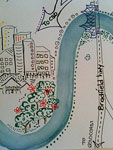"Mapping" Primary and Secondary Sources
Question

Is a map always a primary source? We are having a debate. In our textbook we have a map that is compiled from various sources, so I personally believe it could be a secondary source. Help!
Answer
Librarians and archivists generally agree that a “primary source” is one produced contemporaneously by an eyewitness, participant, or someone with other direct evidence; that is, the person who makes the record is doing so out of his or her firsthand experience of the event or place. Secondary sources are produced by someone without direct experience of the event or place being recorded; secondary sources typically provide a synthesis or interpretation by an author removed from the scene. By this standard, only some maps are primary sources. First, explorer maps are primary sources: for example, maps of Hispaniola produced by Christopher Columbus and his cartographers in the 1490s are original documents created at the time of the encounter. Many other types of maps are primary sources too: the doodle map I create on the back of an envelope to show you the path from my house to the subway is a primary source; “mental maps” that individuals create of the extent of their geographical knowledge of their city or neighborhood are primary sources; maps produced in “real time” by humanitarian organizations in the field to identify the position of people needing assistance—or of the extent of the earthquake damage zone—are primary sources. Even when technology intervenes between the observer and the actual production of the cartography, (that is, the contemporaneous observer may not be the one who literally produces the map), these are primary sources: so, for example, an aerial photograph snapped by a reconnaissance plane several thousand feet overhead, and then translated by an automated cartography program into a map remains a primary source, even though one that is technologically produced. These fairly clear-cut examples aside, the waters then get muddier. A map created in 1870 by a U.S. military commander in Fort Dodge showing Native American-controlled lands in 1870 is a primary source. Even if this map is reproduced in a compilation in 2010, the map itself remains a primary source—assuming the 2010 source exactly reproduces the original without editing or redesign. But a map produced in 1965 showing what land Native Americans controlled in 1870 is a secondary source.
A map compiled from many sources, as you describe in your question, is most likely to be a secondary source. There are two points of confusion: in the first instance, most sources, not just maps, can be both primary and secondary. In the example above, the 1965 map of 1870s Native American land control is a primary source for 1965, but it is a secondary source in relationship to the 1870s. And more confusion arises between “original” and “primary.” That is, if I produce a very clever map showing income inequality state by state, and to do so I draw on information from the General Accounting Office, the U.S. Census, as well as data tables from the U.S. Labor Bureau, I may well produce an “original” and exciting new way of showing income relationships. But, like most works of nonfiction, in order to produce this map I inevitably select bits of the original data sources for use; I use my powers of discrimination and editorial finesse, and I will layer an interpretation over the original data. I may produce an “original” work in the sense that it is a map that no one else has thought of producing, but when you pick it up to use it, it is a secondary source.
Bibliography
Lynch, Kevin. The Image of the City. Cambridge, MA: MIT Press, 1960.
Wood, Denis. The Power of Maps. New York: Guilford Press, 1992.
Yale University. Primary Sources at Yale. 2008. Accessed October 18, 2011.
